These Black Stylists Are Making Headlines for Serving Serious Looks


In honor of Black History Month, we”ve decided to launch an editorial initiative, Next Gen, where we’ll be highlighting creatives that are changing the fashion industry. Our intention with this series is to dive deeper into the people who have and continue to shape every facet of the fashion industry.
Whether looking from within the fashion industry or on its periphery, it’s easy to focus on what’s visibly inadequate: The lack of size-inclusive or disabled models on the runway or the whitening of Black celebrities on covers. Don’t get me wrong—this lack of visual representation is a crucial task to fix. But if we’re going to address systemic racism within the industry, it’s equally essential to pay attention to what’s happening behind the scenes. Often, our discourse about diversity in fashion doesn’t always include the men and women who’ve been shaping fashion forever: Black stylists.
Black stylists shape the cultural zeitgeist; they style the Beyoncé’s of the world, create costumes for shows like Insecure, champion the "Bushwick Birkins,” and shape what is considered "fashionable” long before they’re publicly recognized for doing so. Of course, some stylists have been able to build a public persona for themselves that rivals their A-list clientele, but that doesn’t mean that we’ve been able to address and conquer the inequities that face Black stylists. Consider the fact that Black stylists have historically struggled—and still do—when trying to pull luxury clothing for clients. How is it that many are veterans within the industry but be labeled as "rising talent” as if they weren’t already out here doing the work?
For the industry to truly be inclusive, there needs to be a reckoning with optical tokenism. We have to move beyond having the few go-to Black stylists, the few plus-size models, the few Asian American designers, and give more microphone time, more kudos, and more funding to BIPOC talent. There are so many incredible people of various races, gender orientations, religions, body types, socio-economic backgrounds, and ages that have already been leading change in the fashion industry. We decided we’d dedicate this installment in our Next Gen series to speak specifically to stylists for all these reasons.
Ahead you’ll hear from eight Black stylists not just about what needs to change within the industry but also get to know a little bit more about their work, their worldview, and what fashion means to them on a personal level.
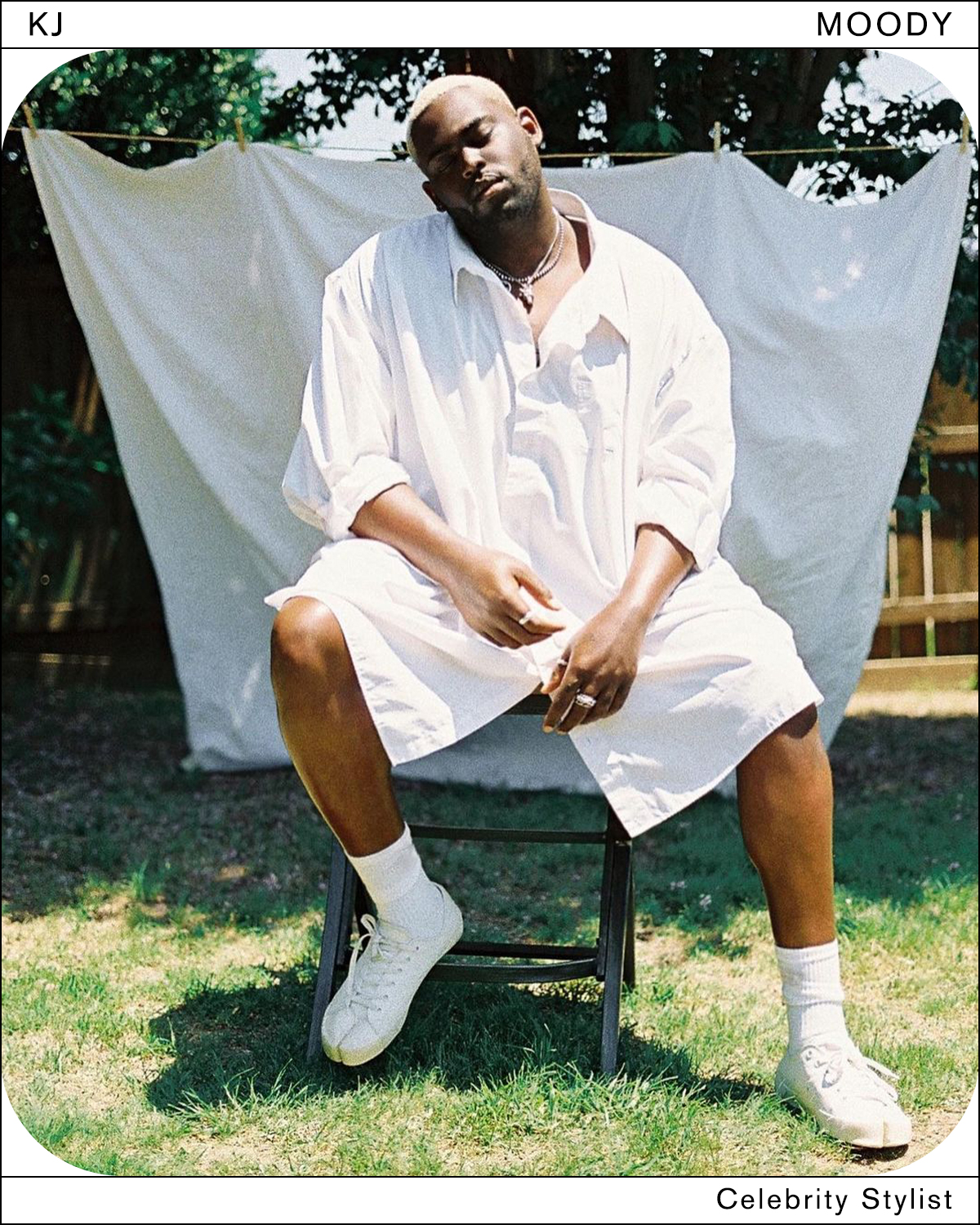
KJ Moody is a celebrity stylist with over nine years of experience in the fashion industry. He studied fashion design at the Art Institute of Dallas, and it was watching reality TV with stylists June Ambrose, Rachel Zoe, and Brad Goreski, that inspired him to get into the business. Since entering the industry, Moody has gone from working under Jeanette Chivvis to a freelance editorial and corporate stylist to becoming the Creative Manager and Stylist for Parkwood Entertainment. If working with Beyoncé isn’t inspiring enough, keep reading to learn more about Moody and his career.

What does style mean to you? And what role do you think identity plays in shaping style both within the collective and as individuals?
KM: Style means personal expression through clothing, hair, makeup, and jewelry. I think identity (i.e., where you grew up and what you feel comfortable with) is a large part of your style’s evolution. Fashion can be shaped by culture; it can be regional, coastal, and shaped by your neighborhood. We all have style preferences based upon our comfort boundaries, even within the collective of what’s "stylish.” But to me, real style is the confidence to establish your style parameters. Even though a look or trend has been defined one way, someone with true style will make it their own.
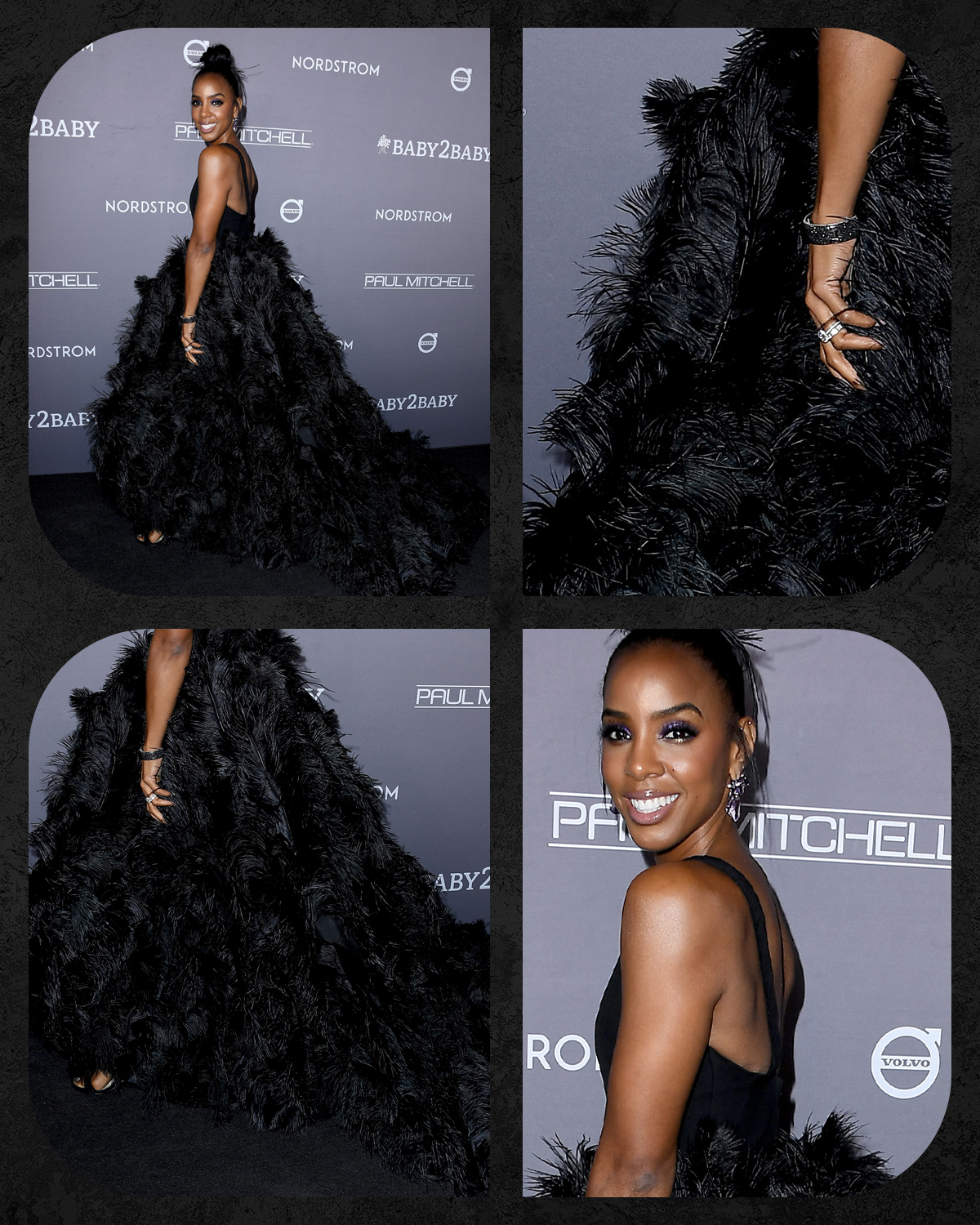
I love the Black community because we have been able to and continuously transform trauma into art. Style, beauty, and creation have been a tool for survival and reckoning forever. What role do you see art playing not only in the collective community but also within your own life?
KM: Art is the magnificent tool we have been able to use to change and sustain us during times of upheaval and unrest. While systemic racism held us down in the past, we still found ways to create something magical through the art of the Black life. We are now more aware of our culture, contributions, ethnic qualities, and special spark that make us different. We have tapped into what makes us unique as a community. What others used to demean and degrade us now stands as badges of value and honor. We are once again proud to be Black people! We no longer need others to affirm us or to validate our talent. While our heritage of artistic abilities is ours and ours alone, we have the power now to choose when and how we share it with the world.

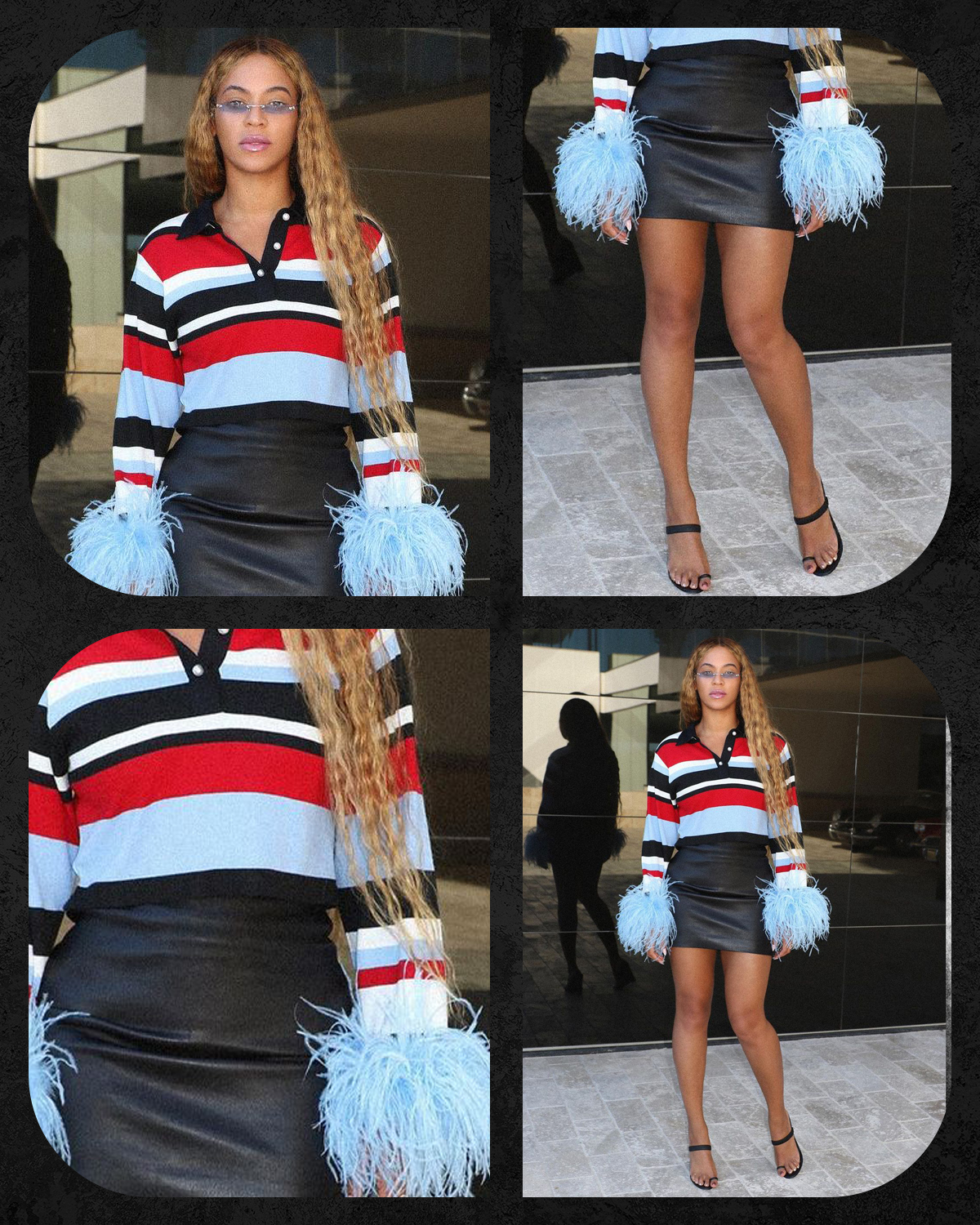
So much of the zeitgeist—from style to beauty to colloquialisms—come from the Black community. What are your thoughts on appreciation versus appropriation, especially when it comes to trends?
KM: There is a fine line between appreciation (paying homage to) and appropriation (taking stealing pieces of culture you don’t understand). I believe appreciation is always a good thing, but appropriation is never acceptable. Unless you are trying to educate in some fashion, it is never okay to appropriate someone’s culture as a trend or make a fashion statement because you feel like it. Anything that demeans the original intentionality or dilutes and popularizes something is never a good thing where race and culture are concerned.

When it comes to styling a client or a shoot, where do you draw inspiration from?
KM: I love to draw inspiration from both street style and my personal cultural experiences. While I focus on my client and their needs, you can find a little bit of Texas in everything I style.
Can you share with us some of your favorite brands to style your clients in?
KM: Right now, it's Michael Costello, Pyer Moss, and Orange Couture.

Fashion and beauty are forms of storytelling. The industry has long been telling stories centered on whiteness and Eurocentric beauty features. What story do you hope your work tells?
KM: I would hope my work tells the story of the beauty of being "different.” Your unique differences and imperfections are what make you beautiful. Being you is not being different because we are all different. It is authentically you where true beauty is found.

Courtney Dion Mays is a menswear stylist and brand consultant. She graduated from the University of Michigan with a degree in Art History. She didn’t first pursue becoming a stylist. In fact, she dabbled in getting her masters, trying to be a plus-size model, and working for Tracy Reese, the first African-American female designer to show at New York Fashion Week. It wasn’t until she began interning for Rachel Johnson in 2006 that styling came into the picture for her. Working under Johnson for six years, Mays was able to meet clients (like LeBron James) and explore the convergence of style and sports. Today, Mays owns her own styling business in Los Angeles. Read on for her perspective on the industry.

What does style mean to you? Would you agree or disagree with the idea that all fashion is political? And what role do you think identity plays in shaping style both within the collective and as individuals?
CM: Style is the way we express ourselves to the world before we open our mouths. It is storytelling and can be political. Through style, we give messages about our identity. Fashion allows us to provide cues about our feelings on sustainability (what fabrics we choose), our connection to social and political issues, our perception of our bodies, what we do for a living, etc. Unfortunately, sometimes our style is an illusion about that identity, but my hope is through my work, I can help men use style as an authentic window into who they are on a personal level.

Fashion over the past few years has had a reckoning with systemic racism. How do you think the industry as a whole can move past performative allyship?
CM: That’s the goal, right? For so long, the fashion industry has exploited Black culture without celebrating the creatives that create the culture. I choose to be optimistic. Hopefully, this allyship is not performative, and we keep this same energy. Form the habit of uplifting Black creatives, normalizing Black creatives in the room; that normalcy will prove that this moment is not a performance.

How do you think the call to action for diversity can be met in your part of the industry?
CM: It has been challenging to align my clients with luxury brands even when they continuously support them. White celebrities and athletes are often overwhelmed with products by brands hoping to get a shot of them wearing pieces from their collection. Simultaneously, we often fight tirelessly for partnerships or recognition. Black athletes are not given the same privileges as their counterparts. Men don’t care about what tuxedo wears on the red carpet, but I guarantee, a large population of men is watching basketball every week. The tunnel walk has become a massive part of that game-watching experience. What an opportunity to influence your consumer. Why wouldn't a brand want to use this moment to target its consumers? I don’t get it.
So rather than waiting to be recognized or pandered to by a community that does not celebrate Blackness, we uplift our creatives. We wear brands by our own people, and we buy them! Circulate the dollar in our community and use that tunnel walk as a moment to introduce those brands to the people who then may become customers.

When it comes to styling a client or a shoot, where do you draw inspiration from?
CM: I am inspired by music, especially jazz (my dad is a trumpet player), art, old photos, and mixed media works. What’s so mesmerizing about all these various art mediums is that they’re celebrating Black people with all of their luxuries. I find that empowering. I also take cues from the client’s spaces, colors, music, artwork, families, and all they love. My goal is to amplify their authentic personal sense of style, not a costume I create for them.
Can you share with us some of your favorite brands to style your clients in?
CM: Just because my clients make millions on the court/field/ice (insert all the sports) doesn’t mean they have to spend all of their money getting dressed. This is why I like to style them in Romeo Hunte, Fear of God, Aime Leon Dore, Todd Patrick, and brands like Todd Snyder, Norse Project, Levi’s, and COS.

What advice would you give an aspiring Black creative looking to break into the fashion industry?
CM: My advice is to continue to learn from those who came before you. Ask for mentorship. Don't be mystified by the illusion of social media. This world appears a lot more glamorous than it is. Be prepared to work very hard. Think outside the box and do not ever allow the industry’s injustices to stop you from pushing forward.

Mickey Boooom Freeman is a fashion stylist. For the Philadelphia-born-and-raised creative, he can’t remember when he wasn’t styling and considers himself his first client. "Fashion was the wind I needed beneath my wings to allow my imagination to soar,” he shared. And soar he has. Since landing his first editorial shoot with top model Terence Telle for GQ Portugal, shot by photographer Djimi Williams, he’s been able to work with clients like Keke Palmer and Peyton List. He’s styled some of our favorite celebrities and cover shoots for quite some time. Keep reading to learn more about what makes Freeman so unique.

What does style mean to you? Would you agree or disagree with the idea that all fashion is political? And what role do you think identity plays in shaping style both within the collective and as individuals?
MF: Style is an extension of one’s spirit that takes place at the moment. Fashion is only political if you make it that way. Identity should be the framework, but not necessarily the singular thing that limits one from evolution.

How can the industry achieve diversity but also avoid tokenism in the process? What would true inclusivity look like in your eyes?
MF: I believe that we all are in dialogue with each other on a cultural level as designers and brands. To move past tokenism, that dialogue has to be transparent in its intent to celebrate the beauty of diversity that comes from an informed and respectful place. I believe that creatives from all walks of life should be conscious that the content they use to create is a system of giving and take. So, in finding ways to pull inspiration from a culture, designers and other creatives should identify ways to give back to it, or at the very least inform their audience of its history and plight.

Fashion and beauty are their forms of storytelling. The industry has long been telling stories centered on whiteness and Eurocentric beauty features. What story do you hope your work tells?
MF: I pray every day that my creative story is one that speaks to how amazingly multifaceted and multidimensional our people are. I hope my journey is a piece in the mosaic that makes up the beauty and creativity we bring to the world.

When it comes to styling a client or a shoot, where do you draw inspiration from?
MF: Inspiration can be drawn directly from what succinctly defines that person or the complete opposite. My ideal situation is where both elements can be juxtaposed to create something never seen before related to the client and shoot.
Can you share with us some of your favorite brands to style your clients in?
MF: Some of my favorite brands to use would be Christian Dior, Hakan Akkaya, Sukeina, Jovana Louis, Ruthie Davis, The Blonds, John Galliano, Christian Siriano, and my namesake brand FreeMen by Mickey. In the future, I look forward to using Pyer Moss, Iris Van Herpen, Christopher John Rogers, Parts of 4, and Schiaparelli, to name a few.

What advice would you give an aspiring Black creative looking to break into the fashion industry?
MF: Do the work. Learn as much as you can by interning, assisting, collaborating, and seeking mentorship. Although I missed the opportunity to help a stylist or have a mentor, I was fortunate enough to intern for fashion designer Anna Sui. Also, listen to your gut! Always remember that you are a vessel, that way, you will forever remain humble. Aside from honing your skills, hard work, humility, and faith are essential.
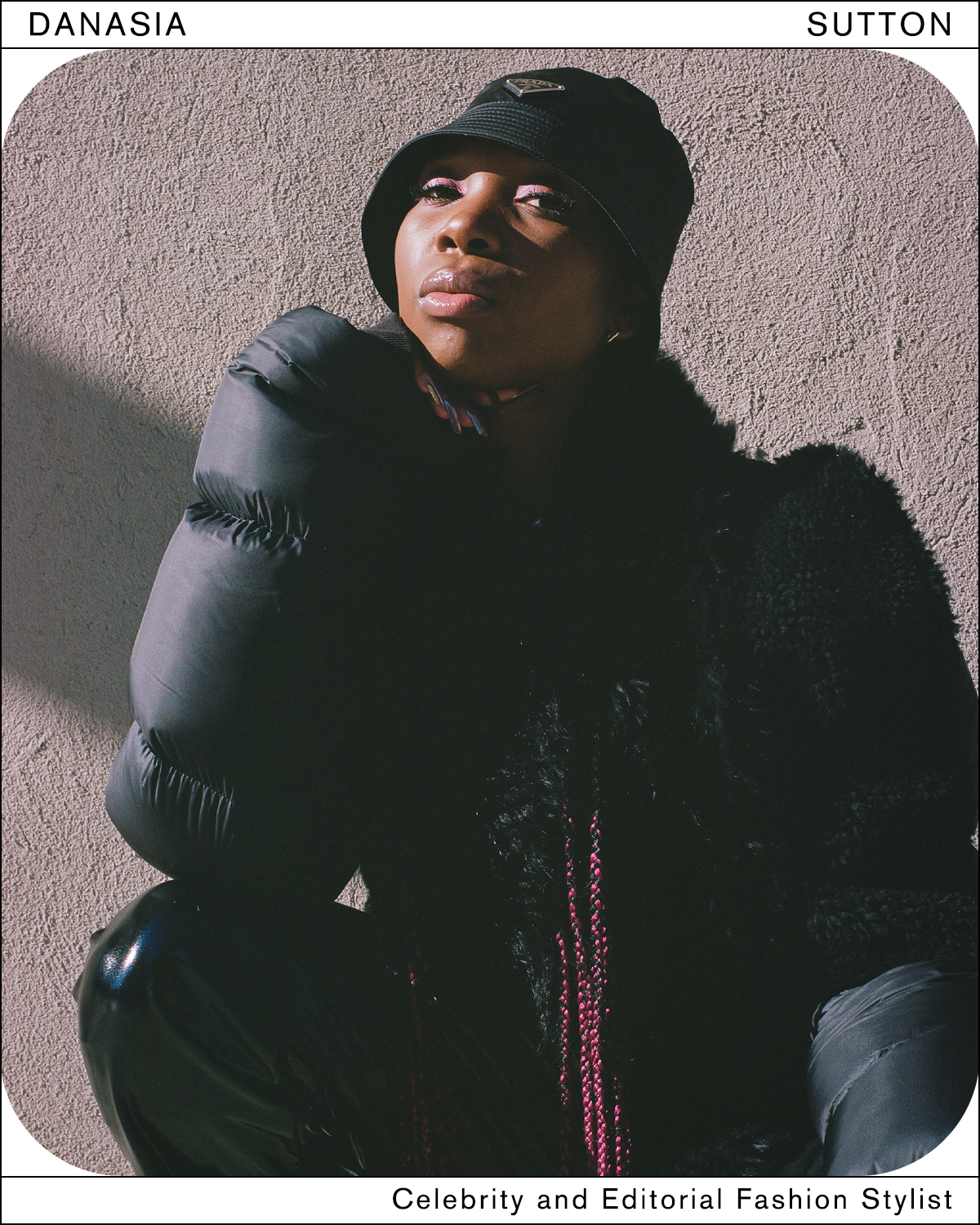
Danasia Sutton is s a Los Angeles–based celebrity and editorial fashion stylist. Sutton’s styling career began almost five years ago as she worked at VFiles in Soho, NYC. She met incredible people, which led her to finally become a freelance stylist. Since branching out, Sutton has made serious strides working with Nike and Gap and clients such as Kehlani, Ciara, and Jameela Jamil. Ahead you’ll hear from the style wiz herself.

What does style mean to you? Would you agree or disagree with the idea that all fashion is political? And what role do you think identity plays in shaping style both within the collective and as individuals?
DS: Style, to me, is your individualism, what sets you apart from everyone. I think identity plays a critical role in shaping style within the collective, and as individuals, you have to be able to think on your own and think for others around you.

Fashion over the past few years has had a reckoning with systemic racism. How do you think the industry as a whole can move past performative allyship? How can the industry achieve diversity but also avoid tokenism in the process? What would true inclusivity look like in your eyes?
DS: I think the industry as a whole can move past performative allyship by using not only well-known Black creatives. They should dig a little deeper and do their research to discover the talent that goes unnoticed. You don’t see too many non-Black performing artists, actresses, or actors working with Black stylists. When they do work with them, it’s someone who is already of significant status. That’s where they need to go in and study who the following new hot creatives are to avoid that tokenism. There’s so much talent out there for them not to be limited to the small pool that they choose from. True inclusivity looks like using new creatives and paying the equal rate that a non-Black person would receive for doing the same job.

So much of the zeitgeist—from style to beauty to colloquialisms—come from the Black community. What are your thoughts on appreciation versus appropriation, especially when it comes to trends?
DS: I don’t see any type of appreciation in a lot of what’s meant to be. It’s accepted when a non-Black person does it, but when we do it, it’s considered "ghetto.” Almost as a form of mockery, like we are taken as some sort of joke. Even with the collective reckoning last year, it’s still seen as such, and it’s sad. It is all considered appropriation in my eyes until they can acknowledge the source in a positive light. We don’t get the credit we deserve.
I love the Black community because we have been able to and continuously transform trauma into art. Style, beauty, and creation have been a tool for survival and reckoning forever. What role do you see art playing not only in the collective community but also within your own life?
DS: I see art in my everyday life, having to face this world that doesn’t want me even to exist, and I’m doing just that—living in my Blackness unapologetically. Wearing what I want to wear, getting glammed up the way I see fit for that day, putting my hair in styles that honor who I am. I am art; we are all art; the world is our gallery. They’re always watching.
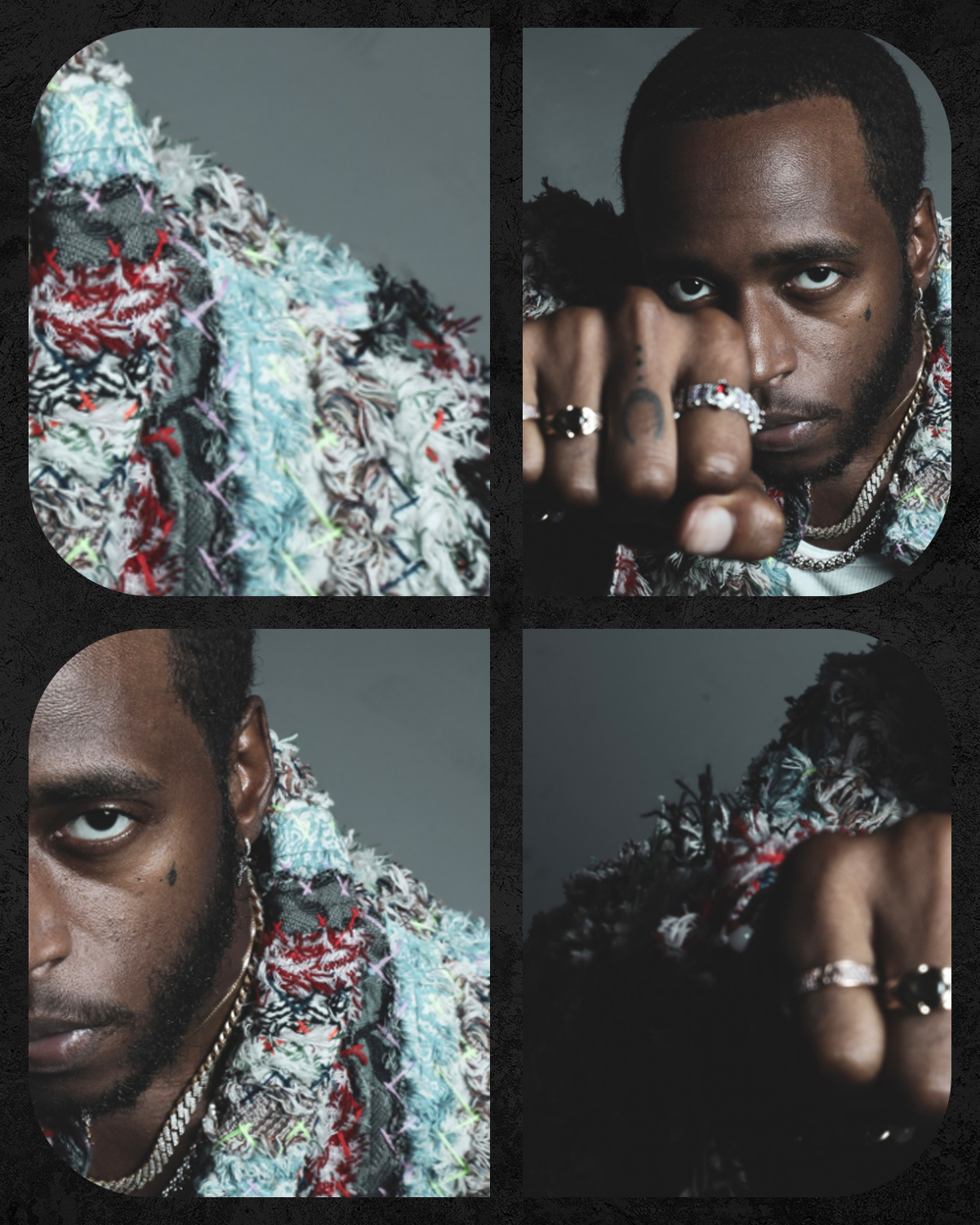
When it comes to styling a client or a shoot, where do you draw inspiration from?
DS: Most of my inspiration comes from excellence. I try to turn any situation into a luxury experience—it doesn’t matter if it’s for an editorial, album cover, music video. Luxury doesn’t always mean diamonds and pearls; I pull energy from the client/shoot and translate how I see fit. I hope my work tells a story of excellence, dreamy realities, and elevation of style within our own culture.

Can you share with us some of your favorite brands to style your clients in?
DS: Some of my top favorite brands to style my clients are Phlemuns, No Sesso, Des Pierrot, and Mowalola. I love everything about these brands and their fresh way of thinking when it comes to their designs. They are all Black-owned and top-tier in my eyes.

Dex Robinson is a celebrity stylist and athlete brand manager with over ten years of experience in the industry. Before he began styling some of our favorite famous men, he worked in fashion public relations and was doing in-house styling for brands for e-commerce, lookbooks, and even NYFW shows. Since then, he has maintained a list of clients that includes Yahya Abdul-Mateen II, Quincy Combs, and Dave East. Ahead you’ll hear what style means to Robinson, and his advice for breaking into the industry.

What does style mean to you? Would you agree or disagree with the idea that all fashion is political?
DR: Style to me is an expression of whatever emotion or message you want to convey at that moment through fashion. It's more than just clothing put together, but it’s the way you carry it and the confidence you display when in it. I also think fashion can be political, and it should be with the current social climate. Be intentional about who you are supporting and do your research.
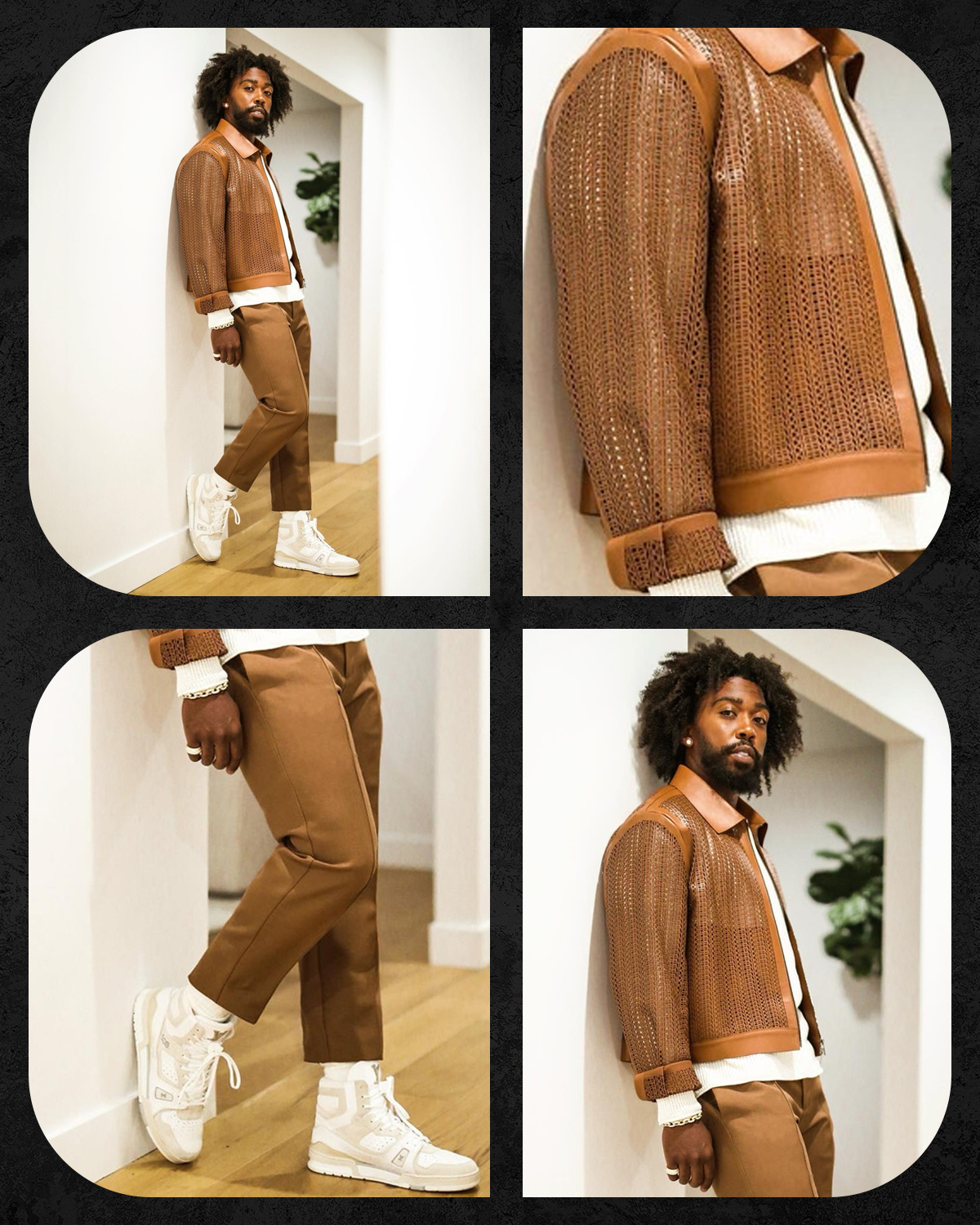
Fashion over the past few years has had a reckoning with systemic racism. How do you think the industry as a whole can move past performative allyship?
DR: By starting to employ more people of color in higher positions with the intention that they would speak up on our behalf before any insincere content is created.

So much of the zeitgeist—from style to beauty to colloquialisms—come from the Black community. What are your thoughts on appreciation versus appropriation, especially when it comes to trends?
DR: One of the most effective ways to understand and appreciate another culture is by listening to those who are a part of that group’s fabric. Make a conscious effort to recognize and credit cultural influences in the things you admire and use. And ultimately fairly compensate when need be if you are monetarily gaining from something you are using.
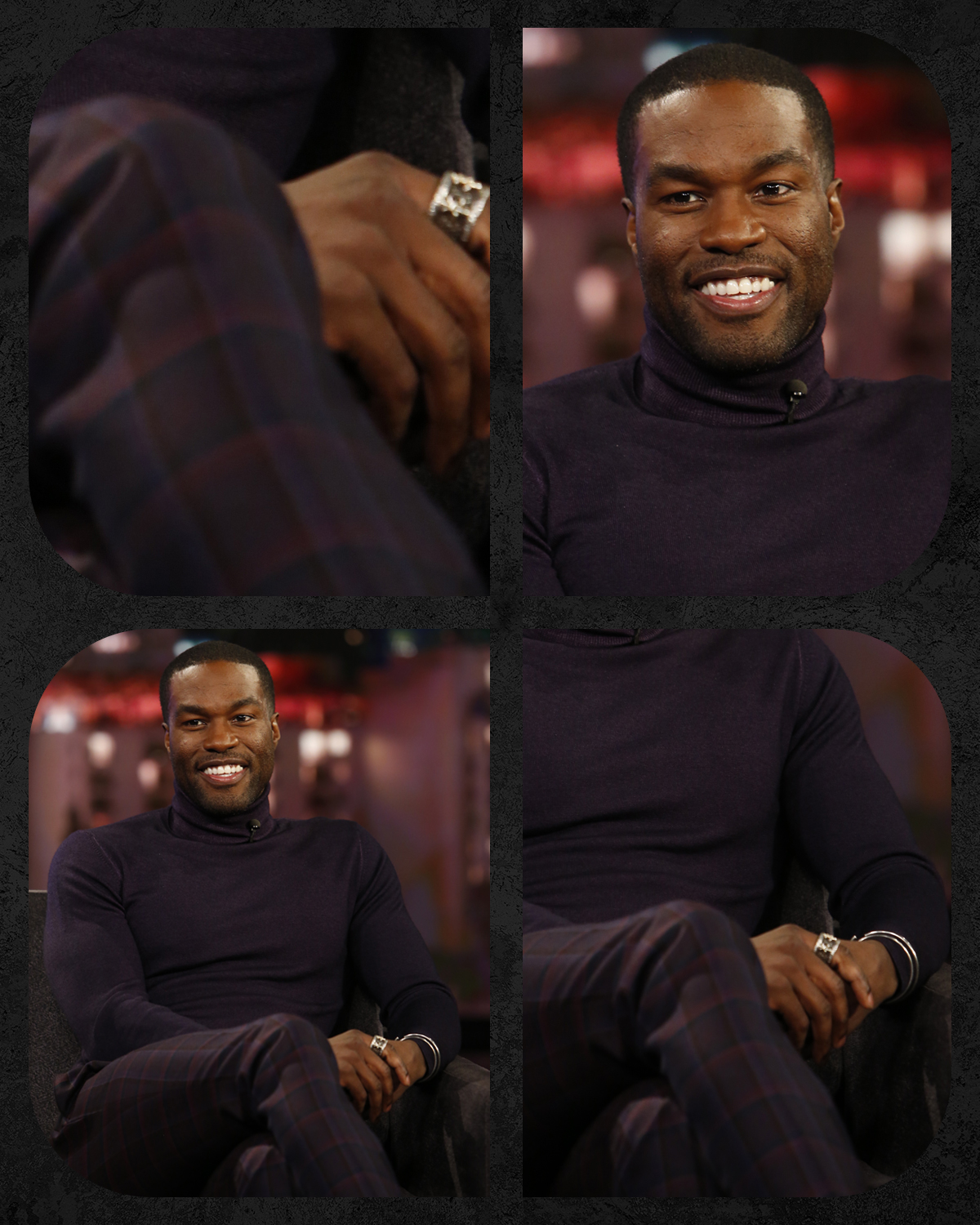
Fashion and beauty are their forms of storytelling—the industry has long been telling stories centered on whiteness and Eurocentric beauty features. What story do you hope your work tells?
DR: Ultimately, I hope my work speaks to various people from different backgrounds and socio-economic statuses. The goal is for people to connect with my work in a way that inspires them to want to do more fashion-wise and appreciate it, even if it isn’t necessarily their style.
Can you share with us some of your favorite brands to style your clients in?
DR: Some of my favorite brands to style my clients would be Pyer Moss, Fear of God, and A-Cold-Wall.

What advice would you give an aspiring Black creative looking to break into the fashion industry?
DR: Be persistent and resourceful. If you want to do something in fashion, it’s not going to be an easy journey but just stay the course. Additionally, use your resources and network. If you know people in the spaces you want to be in, connect with them, ask questions, and build.

Ade Samuel has worked in the fashion industry for over a decade. She studied both at the State University of New York College at Buffalo State and the Fashion Institute of Technology and went on to intern in the editorial space. But it wasn’t until 2016 that Samuel pivoted into the styling space. Since then she’s been able to build a name for herself and a client list that includes Justine Skye, Michael B. Jordan, and Letitia Wright to name a few. Get to know Samuel a little bit more by scrolling ahead.

What does style mean to you? Would you agree or disagree with the idea that all fashion is political? And what role do you think identity plays in shaping style both within the collective and as individuals?
AS: Style is an expression of freedom and a way to celebrate and liberate your heart and inner artist through clothing. I disagree that all fashion is political and (personally) rarely associate fashion and politics when discussing style except when discussing specific references from iconic public figures who happen to be in politics. Women like Jackie Kennedy, Princess Diana, and Michelle Obama were so refreshing to see in those public spaces. Their looks will always be memorable especially in the space of politics and fashion.

How do you think the call to action for diversity can be met in your part of the industry? How can the industry achieve diversity but also avoid tokenism in the process? What would true inclusivity look like in your eyes?
AS: The more opportunities presented to Black creatives to create, organically and authentically, the more authentic inclusivity will become. It's important that industry gate-keepers remember that there is more than one person—that’s tokenism. In my eyes, true Inclusivity is a standard that should be just that: the standard. I hope the industry will continue to move forward as a collective community that creates art and beauty that is reflective of the talent and skills of the Black creative culture.
I love the Black community because we have been able to and continuously transform trauma into art. Style, beauty, and creation have been a tool for survival and reckoning forever. What role do you see art playing not only in the collective community but also within your own life?
AS: Art is an escape. I often utilize my work to make all my visual fashion imaginations come true. I dream it and then want to see it become reality. I feel like that is also what is happening within the diaspora right now and it's accelerating to watch beautiful art in fashion and beauty come to life, especially within the Black creative community.

Can you share with us some of your favorite brands to style your clients in? When it comes to styling a client or a shoot, where do you draw inspiration from?
I love so many designers because I'm constantly inspired by the emerging and established houses. My favorite experience as a stylist is seeing the clothing in motion. A perfectly executed garment is pleasing to my eye and instantly inspires me. This feeling is exactly why I find it difficult to have favorites. Throughout my career, I have been inspired when styling my clients in Pyer Moss, Chanel, Daily Paper, Louis Vuitton, Burberry, Issey Miyake, Valentino, Versace, Telfar, Prada, Tokyo James, Orange Culture, Tongoro, Off-White, Todd Patrick, Landlord, and Sacai. I love the evolving ethos of these brands.

What advice would you give an aspiring Black creative looking to break into the fashion industry?
My advice for aspiring creatives is to truly believe in your whole entire Artistic being. I encourage Black creatives to believe in what they want to create and go out there, put in the hard work, and live in the emotions of it coming to life. I am a firm believer that times have changed and the information today in the digital age is easily accessible. If you become a student of your passion and try to push through the doubt and fear that has been embedded in our culture's generation, then you can break into any industry you desire.

The best things in life come in pairs, and that’s most certainly true when it comes to celebrity stylists, Wayman and Michah. Both began their styling careers in 2013, coming fresh out of the fashion industry in New York. Micah was in merchandising and Wayman had been a fashion assistant at GQ. They met through mutual friends and began to realize through conversations and vision boards that they had a shared vision of the type of clients and styling they wanted to do, and so it was history. Of course, that’s just the beginning of the story—there’s so much more to these men than meets the eye. Keep reading to learn more about what makes this duo so dynamic.

What does style mean to you? Would you agree or disagree with the idea that all fashion is political? And what role do you think identity plays in shaping style both within the collective and as individuals?
W+M: Fashion is inherently political because style represents oneself, and aren’t we all political in some way? Style can be used to fit into a collective or to stand out as an individual. Depending on a person’s own identity, they can use fashion to adapt or stray away from the norm.

Fashion over the past few years has had a reckoning with systemic racism. How do you think the industry as a whole can move past performative allyship?
W+M: Action. It's not just about labeling something unjust—that’s the easy part. We have to identify the root cause of the injustice and rectify the position we are in now. For fashion to move away from performative allyship, the industry must acknowledge its responsibility and take accountability.

How do you think the call to action for diversity can be met in your part of the industry? How can the industry achieve diversity but also avoid tokenism in the process? What would true inclusivity look like in your eyes?
W+M: The key is consistency. We must highlight the talent of BIPOC designers and work with brands who have been focusing on these issues long before they were popularized. By lifting each other as a collective, we can avoid being taken advantage of. As a collective, with as many BIPOC people in the room as possible, we can prevent tokenism in the fashion industry. We believe that the goalpost for true inclusivity is constantly in motion. As long as there’s room for improvement, it will be about keeping the conversation going and trying to be as forward-thinking as possible.
So much of the zeitgeist—from style to beauty to colloquialisms—come from the Black community. What are your thoughts on appreciation versus appropriation, especially when it comes to trends?
W+M: Appreciation brings awareness to other cultures, while appropriation uses different cultures for personal gain. If you are to take a print or basis of a design from another culture, it’s essential to recognize its origins. This could be by involving artisans from that specific culture in the manufacturing process. We believe that there should be a consistent and honest conversation around where inspiration derives from avoiding exploitation.

When it comes to styling a client or a shoot, where do you draw inspiration from?
W+M: We already have a feel for each client’s own inner/personal style, which we always want to highlight. Colors and palettes are still a great foundation, and then it’s about ensuring the silhouette and feel or texture of the fabric makes the client feel special. Most importantly, we never want to change who our clients are. We are focused on bringing their true identity to the foreground.
Can you share with us some of your favorite brands to style your clients in?
W+M: We have fantastic BIPOC designers such as Jason Wu and pioneering Black designers like Christopher John Rogers, Kerby Jean-Raymond of Pyer Moss, and Jason Rembert of Aliette. It’s also always imperative to our clients and us to give platforms to emerging small brands like Renaissance Renaissance, Kiko Kostadinov, Estelle Zou, and Maxrieny by Sara Wong—all four of which Tessa Thompson wore during her Sylvie’s Love press tour. Prada and Gucci have always been incredibly supportive as well.
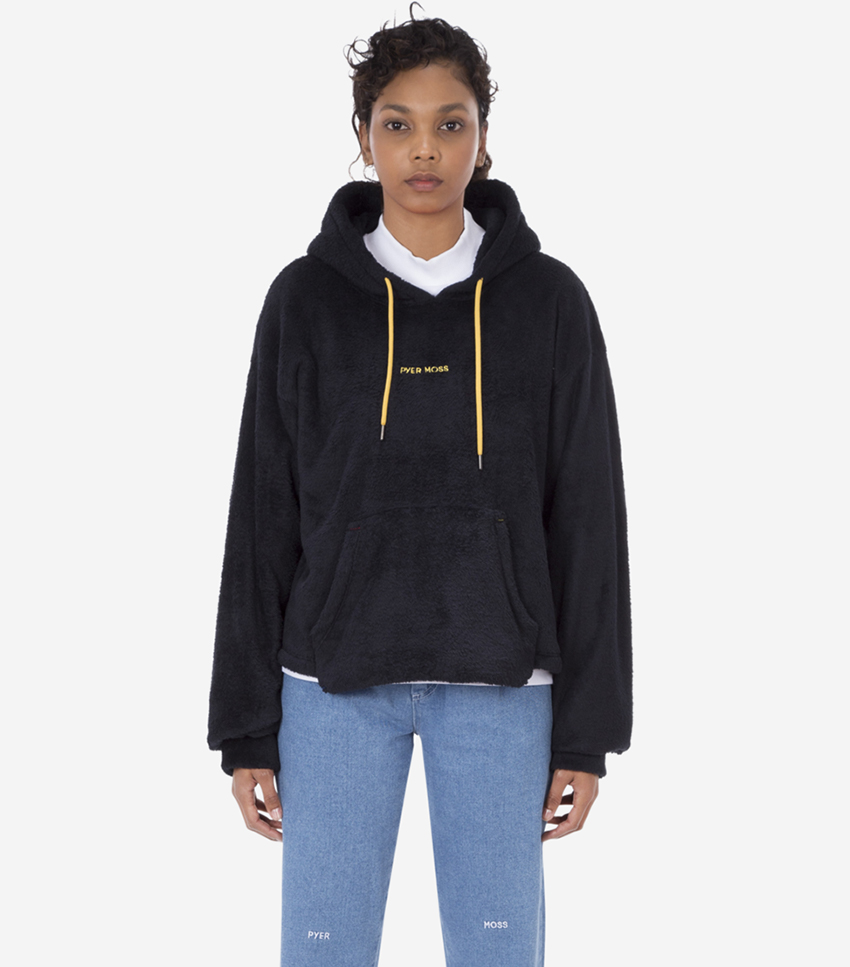
I love the Black community because we have been able to and continuously transform trauma into art. Style, beauty, and creation have been a tool for survival and reckoning forever. What role do you see art playing not only in the collective community but also within your own life?
W+M: Art is one of our most powerful devices to bring forward self-awareness, both on an individual level and in the public sphere. On a larger scale, art can bring together individuals’ experiences and values in the form of fashion. We were brought together by mutual outlooks that helped us to recognize where we existed in our collective, and most importantly, where we wanted to exist.
Next: These 5 Black Designers Are Painting the Future of Fashion

Jasmine Fox-Suliaman is a freelance writer and editor living in New York City. What began as a pastime (blogging on Tumblr) transformed into a lifelong passion for unveiling the connection between fashion and culture on the internet and in real life. Over the last decade, she's melded her extensive edit and social background to various on-staff positions at Who What Wear, MyDomaine, and Byrdie. More recently, she’s become a freelance contributor to other publications including Vogue, Editorialist, and The Cut. Off the clock, you can find her clutching her cell phone as she's constantly scrolling through TikTok and The RealReal, in search of the next cool thing.